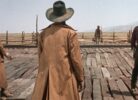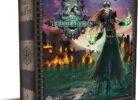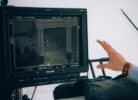Okay, first off, that headline is needless antagonistic. I acknowledge it. Forgive me. I’m listening to punk as I write this. It just seems to fit my mood.
Anyway, prompted by Steven Soderbergh’s interesting recasting of Raiders of the Lost Ark, the other day I was daydreaming and my mind wandered to action scenes in films, specifically why some sprawling action set pieces work and some don’t. The Star Wars prequels were at the forefront of my mind at the time, but it led to a train of thought that is relevant to action movies in general.
Now keep in mind, I’m a big Star Wars fan, but not one of THOSE Star Wars fans. Saw the original in a shitty little theater as a kid, blah blah blah. You know the drill. I’m also not one of those people who froth at the mouth about how the prequels destroyed my childhood. My point is, the second prequel, Attack of the Clones, ends with a massive battle on Geonosis that goes on for 20+ minutes and has TONS of explosions and robots and shit. It’s a huge, chaotic battle that attempts to one-up the Hoth battle from The Empire Strikes Back at every turn.
But it doesn’t. The battle lovely, but it’s also rather incoherent. The entire scene is a lengthy series of impressive looking but completely empty explosions.
This is an issue in a lot of modern movies. The action is big and loud, but there is little sense of forward motion or narrative to it. Sometimes these scenes go on for 15 minutes or more, but it’s all just a jumble of sound and image.
Not EVERY modern action movie, of course. I’m not an old fuddy duddy. The action scenes in Captain America: The Winter Soldier, for example, are well-staged, dynamic, and actually have a sense of narrative and physical space that is easy to follow. Love the car chase with Nick Fury:
Winter Soldier stood out, though, because it got action right when so many modern action flicks confuse cacophony for excitement. Have you SEEN the Transformers movies? Or hell, any post-Saving Private Ryan war film. Throw in enough shaky cam, fast cuts, and closeups, and no one can tell that your action scene doesn’t have an interesting through-line because you beat their senses half to death.
Spielberg, however … this guy understands that actions scenes are in and of themselves little stories, and the ones that work best have tight, impeccable visuals.
The opening sequence of Saving Private Ryan is rightly hailed as one of the greatest feats in cinema history. On the surface, it’s 20+ minutes of bullets, explosions, and torn up limbs. It’s relentless. An assault on the sense that more than a few filmgoers (including this one) found overwhelming.
Spielberg makes it work, though, because it tells a story. MANY stories, in fact. The core of the sequence is, of course, Hanks getting off the boat, up the beach, and leading his men to take the bunkers. There is a narrative that runs through all that hectic action, and one you can easily follow. Hanks goes through a clear journey over the course of this extended sequence.
But there is more. In a big battle scene like that, you want to cut away to other moments in order to show the scale of what’s happening. You see this is almost all big action set pieces like this. Show this thing blowing up, show those people dying, show that amazing sight. What Spielberg does, though, is ensure every one of those little cutaways tells a miniature, self-contained story. Look close at the seeming chaos of that Saving Private Ryan scene and you’ll notice that the “chaos” is all actually a series of focused moments, each intended to say something:
- The doctor checking over a row of bodies and giving his assessment.
- The guy who gets saved by his helmet, only to be shot a moment later
- Burning the Germans out of the bunkers and then deciding to let them burn.
And so on.
These are small narrative moments that punctuate the action in meaningful ways. You come away not having seen an overwhelming series of explosions, but an actual narrative that fits together as a series of important moments that can be clearly followed.
That Attack of the Clones sequence, meanwhile, is an excuse to show off lots of badass CGI and cool robot designs, but can you spot the narrative in it? Can you remember any specific moments?
Spielberg is a storyteller first and foremost. Even in his most audacious, self-indulgent moments, he’s laser-focused on sending the audience on a journey, and he does so in a way that generally needs no trickery or hand-holding. All that sprawl and spectacle has something to SAY. And because of that, it works.
I guess that’s he is Spielberg and Bay is Bay.







